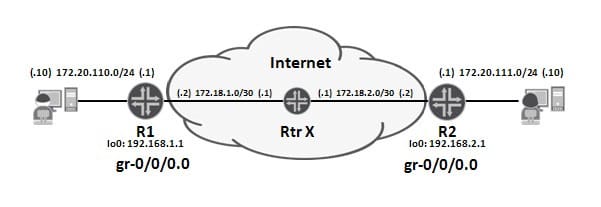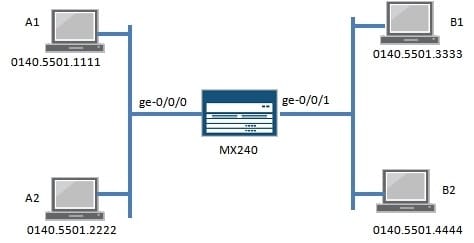Exam Details
Exam Code
:JN0-361Exam Name
:Service Provider Routing and Switching, Specialist (JNCIS-SP)Certification
:Juniper CertificationsVendor
:JuniperTotal Questions
:542 Q&AsLast Updated
:
Juniper Juniper Certifications JN0-361 Questions & Answers
-
Question 431:
Which two statements describe differences between IPv4 and IPv6? (Choose two)
A. IPsec is built into IPv6
B. IPv6 uses a 32-bit (4-byte) address and can support up to 4,294,967,296 addresses
C. IPv4 supports extension headers whereas IPv6 options are integrated into the base
D. IPv6 eliminates the need for NAT
-
Question 432:
You must configure an OSPF area that does not accept type 3 link-state advertisements (LSAs) from area 0 (other than the default route) You have configured your area to be stub, but you still see type 3 LSAs.
What will account for this behavior?
A. You should have configured your area as totally stubby
B. You should have used a not-so-stubby-area
C. You are experiencing a routing loop
D. You have exported routes into OSPF
-
Question 433:
-- Exhibit --- Exhibit -

Click the Exhibit button.
Based on the exhibit, which configuration will permit end-to-end routing through the GRE tunnel for R1?
A. [edit] user@R1# show routing-options static route 192.168.2.1/32 next-hop gr-0/0/0.0; route 172.20.111.0/24 next-hop 192.168.1.1;
B. [edit] user@R1# show routing-options static route 192.168.2.1/32 next-hop gr-0/0/0.0; route 172.20.111.0/24 next-hop 172.18.1.1;
C. [edit] user@R1# show routing-options static route 192.168.2.1/32 next-hop 172.18.1.1; route 172.20.111.0/24 next-hop gr-0/0/0.0;
D. [edit] user@R1# show routing-options static route 192.168.2.1/32 next-hop 172.18.2.2; route 172.20.111.0/24 next-hop 172.18.1.1;
-
Question 434:
What are two valid actions that can be applied to a frame by a Layer 2 firewall filter? (Choose two)
A. Log
B. loss-priority
C. sample
D. count
-
Question 435:
-- Exhibit -

-- Exhibit -Click the Exhibit button.
In the exhibit, all switches run STP; however, the link between bridge G and bridge E fails.
What does root bridge A do after it receives information about this link failure?
A. Root bridge A sets the acknowledge flag and sends an updated topology BPDU.
B. Root bridge A sends a topology change notification BPDU.
C. Root bridge A sets the topology change flag and sends an updated configuration BPDU.
D. Root bridge A floods an updated BPDU topology database.
-
Question 436:
-- Exhibit -

-- Exhibit -Click the Exhibit button. Referring to the exhibit, you have an established RSVP LSP between R1 and R5 when you experience a link failure between R2 and R4.
Which two statements are correct? (Choose two.)
A. R2 sends a ResvTear message upstream to R1 signaling the link failure.
B. R2 sends a PathTear message upstream to R1 signaling the link failure.
C. R4 sends a ResvTear message downstream to R5 signaling the link failure.
D. R4 sends a PathTear message downstream to R5 signaling the link failure.
-
Question 437:
-- Exhibit -[edit]
user@router# show protocols bgp
group ibgp {
type internal;
local-address 3.3.3.3;
family inet;
neighbor 2.2.2.2;
}
[edit]
user@router# show routing-instances
VRF {
instance-type vrf;
interface xe-0/0/1.0;
route-distinguisher 3.3.3.3:100;
vrf-target target:100:100;
vrf-table-label;
}
[edit]
user@router# show protocols mpls
interface all;
[edit]
user@router# show protocols rsvp
interface all;
-- Exhibit -
Click the Exhibit button.
Referring to the exhibit, what is missing in the configuration to make the Layer 3 VPN functional? (Choose
two.)
A. a label-switched path
B. the LDP protocol configuration
C. a virtual circuit ID
D. an NLRI of family inet-vpn unicast
-
Question 438:
-- Exhibit -
user@router# show interfaces
xe-0/0/0 {
unit 0 {
family inet {
address 192.168.12.1/24;
}
family mpls;
}
}
xe-0/0/1 {
encapsulation ethernet-ccc;
unit 0 {
family ccc;
}
}
lo0 {
unit 0 {
family inet {
address 1.1.1.1/32;
}
}
}
[edit]
user@router# show protocols
mpls {
interface all;
}
ospf {
traffic-engineering;
area 0.0.0.0 {
interface all;
}
}
ldp {
interface all;
}
l2circuit {
neighbor 2.2.2.2 {
interface xe-0/0/1.0 {
}
}
}
-- Exhibit -
Click the Exhibit button.
In the exhibit, which configuration element is missing to bring up the Layer 2 circuit?
A. the route target
B. the virtual circuit ID
C. a targeted LDP session
D. an MPLS LSP
-
Question 439:
-- Exhibit -

-- Exhibit -
Click the Exhibit button.
In the exhibit, A1 sends a broadcast frame with destination MAC address FFFF.FFFF.FFFF, and all other stations have sent a response .
What would be the correct MAC address table on the MX240? ge-0/0/0 0140.5501.1111
A. ge-0/0/0 FFFF.FFFF.FFFF
B. ge-0/0/0 FFFF.FFFF.FFFF
C. ge-0/0/0 0140.5501.2222 ge-0/0/1 0140.5501.3333 ge-0/0/1 0140.5501.4444 ge-0/0/0 0140.5501.1111
D. ge-0/0/0 0140.5501.2222 ge-0/0/1 0140.5501.3333 ge-0/0/1 0140.5501.4444
-
Question 440:
-- Exhibit -user@router> show configuration routing-options
autonomous-system 65001;
user@router> show configuration protocols bgp
group 65002 {
traceoptions {
file bgp-trace;
flag open detail;
}
neighbor 192.168.100.2 {
peer-as 65002;
}
}
user@router> show log bgp-trace
Feb 5 20:07:08 trace_on: Tracing to "/var/log/bgp-trace" started
Feb 5 20:08:23.477912 bgp_senD. sending 63 bytes to 192.168.100.2 (External AS 65002)
Feb 5 20:08:23.478040
Feb 5 20:08:23.478040 BGP SEND 192.168.100.1+62776 -> 192.168.100.2+179
Feb 5 20:08:23.478077 BGP SEND message type 1 (Open) length 63
Feb 5 20:08:23.478100 BGP SEND version 4 as 65001 holdtime 90 id 10.200.1.4 parmlen 34
Feb 5 20:08:23.478119 BGP SEND MP capability AFI=1, SAFI=1
Feb 5 20:08:23.478138 BGP SEND Refresh capability, code=128
Feb 5 20:08:23.478155 BGP SEND Refresh capability, code=2
Feb 5 20:08:23.478176 BGP SEND Restart capability, code=64, time=120, flags=
Feb 5 20:08:23.478196 BGP SEND Restart capability AFI=1, SAF=1, Flags=ForwardingSaved
Feb 5 20:08:23.478217 BGP SEND 4 Byte AS-Path capability (65), as_num 65001
Feb 5 20:08:23.478820
Feb 5 20:08:23.478820 BGP RECV 192.168.100.2+179 -> 192.168.100.1+62776
Feb 5 20:08:23.478859 BGP RECV message type 1 (Open) length 59
Feb 5 20:08:23.478880 BGP RECV version 4 as 65003 holdtime 90 id 192.168.1.1 parmlen 30
Feb 5 20:08:23.478899 BGP RECV MP capability AFI=1, SAFI=1
Feb 5 20:08:23.478918 BGP RECV Refresh capability, code=128
Feb 5 20:08:23.478935 BGP RECV Refresh capability, code=2
Feb 5 20:08:23.478955 BGP RECV Restart capability, code=64, time=120, flags=
Feb 5 20:08:23.478974 BGP RECV 4 Byte AS-Path capability (65), as_num 65003
Feb 5 20:08:23.479057 bgp_process_open: : NOTIFICATION sent to 192.168.100.2 (External AS 65002):
code 2 (Open Message Error) subcode 2 (bad peer AS number), Reason: peer 192.168.100.2 (External
AS 65002) claims 65003, 65002 configured
Feb 5 20:08:23.479083 bgp_senD. sending 21 bytes to 192.168.100.2 (External AS 65002)
Feb 5 20:08:23.479104
Feb 5 20:08:23.479104 BGP SEND 192.168.100.1+62776 -> 192.168.100.2+179
Feb 5 20:08:23.479136 BGP SEND message type 3 (Notification) length 21
Feb 5 20:08:23.479156 BGP SEND Notification code 2 (Open Message Error) subcode 2 (bad peer AS
number)
-- Exhibit -
Click the Exhibit button.
You have been asked to configure an EBGP peering to AS 65002. The EBGP peering is stuck in an Active
state.
Referring to the exhibit, what would be changed to bring up the peering?
A. Configure the local-as to 65003.
B. Configure the autonomous-system to 65003.
C. Configure the EBGP peering as passive.
D. Configure the peer-as to 65003.
Related Exams:
JN0-102
Internet Associate, Junos(JNCIA-Junos)JN0-104
Junos, Associate (JNCIA-Junos)JN0-105
Junos, Associate (JNCIA-Junos)JN0-1101
Juniper Networks Certified Design Associate (JNCDA)JN0-1103
Design, Associate (JNCIA-Design)JN0-130
Juniper networks Certified internet specialist.e(jncis-e)JN0-1301
Data Center Design, Specialist (JNCDS-DC)JN0-1302
Data Center Design Specialist (JNCDS-DC)JN0-1331
Security Design, Specialist (JNCDS-SEC)JN0-1332
Security Design, Specialist (JNCDS-SEC)
Tips on How to Prepare for the Exams
Nowadays, the certification exams become more and more important and required by more and more enterprises when applying for a job. But how to prepare for the exam effectively? How to prepare for the exam in a short time with less efforts? How to get a ideal result and how to find the most reliable resources? Here on Vcedump.com, you will find all the answers. Vcedump.com provide not only Juniper exam questions, answers and explanations but also complete assistance on your exam preparation and certification application. If you are confused on your JN0-361 exam preparations and Juniper certification application, do not hesitate to visit our Vcedump.com to find your solutions here.